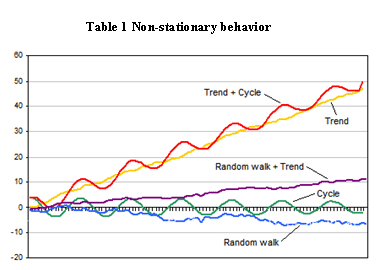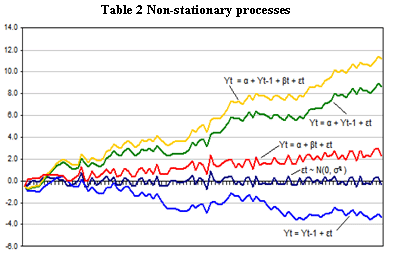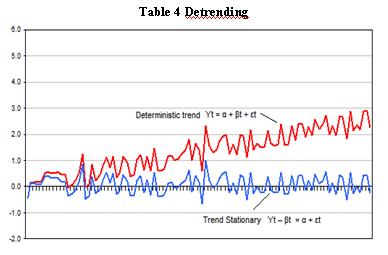Friday, July 17, 2015
Introduction To Stationary And Non-Stationary Processes
Introduction To Stationary And Non-Stationary Processes
Financial institutions and corporations as well as individual investors and researchers often use financial time series data (such as asset prices, exchange rates, GDP, inflation and other macroeconomic indicators) in economic forecasts, stock market analysis or studies of the data itself.
But refining data is key to being able to apply it to your stock analysis. In this article, we'll show you how to isolate the data points that are relevant to your stock reports.
Cooking Raw Data
Data points are often non-stationary or have means, variances and covariances that change over time. Non-stationary behaviors can be trends, cycles, random walks or combinations of the three.
Non-stationary data, as a rule, are unpredictable and cannot be modeled or forecasted. The results obtained by using non-stationary time series may be spurious in that they may indicate a relationship between two variables where one does not exist. In order to receive consistent, reliable results, the non-stationary data needs to be transformed into stationary data. In contrast to the non-stationary process that has a variable variance and a mean that does not remain near, or returns to a long-run mean over time, the stationary process reverts around a constant long-term mean and has a constant variance independent of time.
 |
| Figure 1 |
Types of Non-Stationary ProcessesBefore we get to the point of transformation for the non-stationary financial time series data, we should distinguish between the different types of the non-stationary processes. This will provide us with a better understanding of the processes and allow us to apply the correct transformation. Examples of non-stationary processes are random walk with or without a drift (a slow steady change) and deterministic trends (trends that are constant, positive or negative, independent of time for the whole life of the series).
 |
| Figure 2 |
- Pure Random Walk (Yt = Yt-1 + εt )Random walk predicts that the value at time "t" will be equal to the last period value plus a stochastic (non-systematic) component that is a white noise, which means εt is independent and identically distributed with mean "0" and variance "σ²". Random walk can also be named a process integrated of some order, a process with a unit root or a process with a stochastic trend. It is a non mean reverting process that can move away from the mean either in a positive or negative direction. Another characteristic of a random walk is that the variance evolves over time and goes to infinity as time goes to infinity; therefore, a random walk cannot be predicted.
- Random Walk with Drift (Yt = α + Yt-1 + εt )If the random walk model predicts that the value at time "t" will equal the last period's value plus a constant, or drift (α), and a white noise term (εt), then the process is random walk with a drift. It also does not revert to a long-run mean and has variance dependent on time.
- Deterministic Trend (Yt = α + βt + εt )Often a random walk with a drift is confused for a deterministic trend. Both include a drift and a white noise component, but the value at time "t" in the case of a random walk is regressed on the last period's value (Yt-1), while in the case of a deterministic trend it is regressed on a time trend (βt). A non-stationary process with a deterministic trend has a mean that grows around a fixed trend, which is constant and independent of time.
- Random Walk with Drift and Deterministic Trend (Yt = α + Yt-1 + βt + εt )
Another example is a non-stationary process that combines a random walk with a drift component (α) and a deterministic trend (βt).It specifies the value at time "t" by the last period's value, a drift, a trend and a stochastic component. (To learn more about random walks and trends, see our Financial Concepts tutorial.)
Trend and Difference StationaryA random walk with or without a drift can be transformed to a stationary process by differencing (subtracting Yt-1 from Yt, taking the difference Yt - Yt-1) correspondingly to Yt - Yt-1 = εt or Yt - Yt-1 = α + εt and then the process becomes difference-stationary. The disadvantage of differencing is that the process loses one observation each time the difference is taken.
 |
| Copryright © 2007 Investopedia.com |
| Figure 3 |
A non-stationary process with a deterministic trend becomes stationary after removing the trend, or detrending. For example, Yt = α + βt + εt is transformed into a stationary process by subtracting the trend βt: Yt - βt = α + εt, as shown in Figure 4 below. No observation is lost when detrending is used to transform a non-stationary process to a stationary one.
 |
| Figure 4 |
In the case of a random walk with a drift and deterministic trend, detrending can remove the deterministic trend and the drift, but the variance will continue to go to infinity. As a result, differencing must also be applied to remove the stochastic trend.
ConclusionUsing non-stationary time series data in financial models produces unreliable and spurious results and leads to poor understanding and forecasting. The solution to the problem is to transform the time series data so that it becomes stationary. If the non-stationary process is a random walk with or without a drift, it is transformed to stationary process by differencing. On the other hand, if the time series data analyzed exhibits a deterministic trend, the spurious results can be avoided by detrending. Sometimes the non-stationary series may combine a stochastic and deterministic trend at the same time and to avoid obtaining misleading results both differencing and detrending should be applied, as differencing will remove the trend in the variance and detrending will remove the deterministic trend.
Saturday, June 20, 2015
Mergers and Acquisition Research Material
Journal Of Management (JOM)
Association of Corporate Growth
e-journal on Mergers & Acquisitions
Journal of Business Strategy
Oxford Journal
Houston Business Journal
Wall Street Journal
Books and Journals-Michigan University
Elsevier
Oil & Gas Financial Journal
Marketing Research
American Marketing Association
International Journal of Marketing Research
Papers
Merger Movements in American Industry, 1895-1956
Markup pricing in mergers and acquisitions
Thirty Years of Mergers and Acquisitions Research: Recent Advances and Future Opportunities
Acculturation in Mergers and Acquisitions
The Post-merger Performance Puzzle
The effect of mergers and acquisitions on the efficiency and profitability of EC credit institutions
Integrating Strategic, Organizational, and Human Resource Perspectives on Mergers and Acquisitions: A Case Survey of Synergy Realization
Mergers and Acquisitions of Financial Institutions: A Review of the Post-2000 Literature
Returns to bidding firms in mergers and acquisitions: Reconsidering the relatedness hypothesis
Making mergers and acquisitions work: What we know and don't know – Part I
Friday, February 27, 2015
List of Nobel Memorial Prize laureates in Economics
| Year | Laureate | Country | Schools of economic thought | Rationale | |
|---|---|---|---|---|---|
| 1969 |  | Ragnar Frisch | "for having developed and applied dynamic models for the analysis of economic processes"[2] | ||
 | Jan Tinbergen | ||||
| 1970 |  | Paul Samuelson | Keynesian | "for the scientific work through which he has developed static and dynamic economic theory and actively contributed to raising the level of analysis in economic science"[8] | |
| 1971 |  | Simon Kuznets | Institutional | "for his empirically founded interpretation of economic growth which has led to new and deepened insight into the economic and social structure and process of development"[9] | |
| 1972 | John Hicks | Keynesian | "for their pioneering contributions to general economic equilibrium theory and welfare theory."[10] | ||
 | Kenneth Arrow | Neoclassical | |||
| 1973 | Wassily Leontief | "for the development of the input-output method and for its application to important economic problems"[11] | |||
| 1974 |  | Gunnar Myrdal | Monetarism | "for their pioneering work in the theory of money and economic fluctuations and for their penetrating analysis of the interdependence of economic, social and institutional phenomena."[12] | |
 | Friedrich Hayek | Austrian | |||
| 1975 |  | Leonid Kantorovich | "for their contributions to the theory of optimum allocation of resources"[13] | ||
| Tjalling Koopmans | |||||
| 1976 |  | Milton Friedman | Chicago | "for his achievements in the fields of consumption analysis, monetary history and theory and for his demonstration of the complexity of stabilisation policy"[14] | |
| 1977 |  | Bertil Ohlin | Stockholm | "for their pathbreaking contribution to the theory of international trade and internationalcapital movements"[15] | |
 | James Meade | Keynesian | |||
| 1978 |  | Herbert A. Simon | Carnegie | "for his pioneering research into the decision-making process within economic organizations"[16] | |
| 1979 | Theodore Schultz | Chicago | "for their pioneering research into economic development research with particular consideration of the problems of developing countries."[17] | ||
| Arthur Lewis | |||||
| 1980 | Lawrence Klein | Keynesian | "for the creation of econometric models and the application to the analysis of economic fluctuations and economic policies"[18] | ||
| 1981 | James Tobin | Keynesian | "for his analysis of financial markets and their relations to expenditure decisions, employment, production and prices"[19] | ||
| 1982 | George Stigler | Chicago | "for his seminal studies of industrial structures, functioning of markets and causes and effects of public regulation"[20] | ||
| 1983 |  | Gérard Debreu | Neoclassical | "for having incorporated new analytical methods into economic theory and for his rigorous reformulation of the theory of general equilibrium"[21] | |
| 1984 | Richard Stone | "for having made fundamental contributions to the development of systems of national accounts and hence greatly improved the basis for empirical economic analysis"[22] | |||
| 1985 |  | Franco Modigliani | Keynesian | "for his pioneering analyses of saving and of financial markets"[23] | |
| 1986 |  | James M. Buchanan | Chicago | "for his development of the contractual and constitutional bases for the theory of economic and political decision-making"[24] | |
| 1987 |  | Robert Solow | Keynesian | "for his contributions to the theory of economic growth"[25] | |
| 1988 |  | Maurice Allais | Neoclassical | "for his pioneering contributions to the theory of markets and efficient utilization of resources"[26] | |
| 1989 |  | Trygve Haavelmo | Keynesian | "for his clarification of the probability theory foundations of econometrics and his analyses of simultaneous economic structures"[27] | |
| 1990 | Harry Markowitz | Chicago | "for their pioneering work in the theory of financial economics"[28] | ||
| Merton Miller | Chicago | ||||
 | William Forsyth Sharpe | ||||
| 1991 | Ronald Coase | Chicago | "for his discovery and clarification of the significance of transaction costs and property rights for the institutional structure and functioning of the economy"[29] | ||
| 1992 |  | Gary Becker | Chicago | "for having extended the domain of microeconomic analysis to a wide range of human behaviour and interaction, including non-market behaviour"[30] | |
| 1993 |  | Robert Fogel | Chicago | "for having renewed research in economic history by applying economic theory and quantitative methods in order to explain economic and institutional change"[31] | |
| Douglass North | New institutional | ||||
| 1994 | John Harsanyi | "for their pioneering analysis of equilibria in the theory of non-cooperative games."[32] | |||
 | John Forbes Nash | ||||
 | Reinhard Selten | ||||
| 1995 | Robert Lucas, Jr. | New classical | "for having developed and applied the hypothesis of rational expectations, and thereby having transformed macroeconomic analysis and deepened our understanding of economic policy"[33] | ||
| 1996 | James Mirrlees | "for their fundamental contributions to the economic theory of incentives under asymmetric information"[34] | |||
| William Vickrey | Keynesian | ||||
| 1997 |  | Robert C. Merton | "for a new method to determine the value of derivatives."[35] | ||
 | Myron Scholes | Chicago | |||
| 1998 |  | Amartya Sen | Capability approach | "for his contributions to welfare economics"[36] | |
| 1999 |  | Robert Mundell | Keynesian | "for his analysis of monetary and fiscal policy under different exchange rate regimes and his analysis of optimum currency areas"[37] | |
| 2000 |  | James Heckman | Chicago | "for his development of theory and methods for analyzing selective samples"[38] | |
 | Daniel McFadden | "for his development of theory and methods for analyzing discrete choice"[38] | |||
| 2001 |  | George Akerlof | Keynesian | "for their analyses of markets with asymmetric information"[39] | |
 | Michael Spence | ||||
 | Joseph E. Stiglitz | Keynesian | |||
| 2002 |  | Daniel Kahneman | Behavioral | "for having integrated insights from psychological research into economic science, especially concerning human judgment and decision-making under uncertainty"[40] | |
 | Vernon L. Smith | New classical | "for having established laboratory experiments as a tool in empirical economic analysis, especially in the study of alternative market mechanisms"[40] | ||
| 2003 |  | Robert F. Engle | "for methods of analyzing economic time series with time-varying volatility (ARCH)"[41] | ||
 | Clive Granger | "for methods of analyzing economic time series with common trends (cointegration)"[41] | |||
| 2004 |  | Finn E. Kydland | New classical | "for their contributions to dynamic macroeconomics: the time consistency of economic policy and the driving forces behind business cycles."[42] | |
 | Edward C. Prescott | New classical | |||
| 2005 |  | Robert J. Aumann | "for having enhanced our understanding of conflict and cooperation through game-theoryanalysis."[43] | ||
 | Thomas C. Schelling | ||||
| 2006 |  | Edmund S. Phelps | "for his analysis of intertemporal tradeoffs in macroeconomic policy"[44] | ||
| 2007 |  | Leonid Hurwicz | "for having laid the foundations of mechanism design theory"[45] | ||
 | Eric S. Maskin | ||||
 | Roger B. Myerson | ||||
| 2008 |  | Paul Krugman | Keynesian | "for his analysis of trade patterns and location of economic activity"[46] | |
| 2009 |  | Elinor Ostrom | New institutional | "for her analysis of economic governance, especially the commons"[47] | |
 | Oliver E. Williamson | New institutional | "for his analysis of economic governance, especially the boundaries of the firm"[47] | ||
| 2010 |  | Peter A. Diamond | "for their analysis of markets with search frictions"[48] | ||
 | Dale T. Mortensen | ||||
 | Christopher A. Pissarides | ||||
| 2011 |  | Thomas J. Sargent | Neoclassical | "for their empirical research on cause and effect in the macroeconomy" | |
 | Christopher A. Sims | Neoclassical | |||
| 2012 |  | Alvin E. Roth | "for the theory of stable allocations and the practice of market design." | ||
 | Lloyd S. Shapley | ||||
| 2013 |  | Eugene F. Fama | Chicago | "for their empirical analysis of asset prices." | |
 | Lars Peter Hansen | Chicago | |||
| Robert J. Shiller | Keynesian | ||||
| 2014 | Jean Tirole | "for his analysis of market power and regulation". | |||
Subscribe to:
Comments (Atom)



















